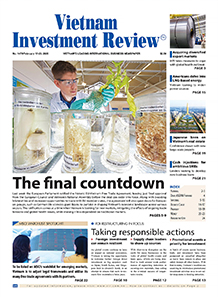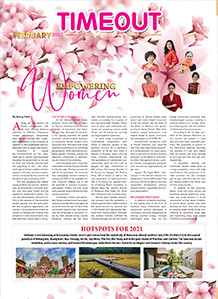2020 targets roused by robust exports
 |
In December 2018, the Ministry of Industry and Trade (MoIT) hailed a record export-import turnover of $482.2 billion, which was a “very impressive achievement”, greatly contributed to economic growth.
One year later, the record was broken, with the country reaping a new record of $517 billion and $10 billion in trade surplus – something that had never been dreamed of previously.
A ceremony has been held by the MoIT to welcome the fruits, deemed as one of the largest events in the economic picture in 2019.
So far, Vietnam has developed to join the group of 30 leading export-import economies in the world, as well as witnessed a strong progression of its imports and exports over the years. The country’s total import and export turnover in the last 20 years reached almost $4 trillion. Regarding the number of export markets, Vietnam had only 24 such markets in 2011 with the export turnover of at least $1 billion each, with the number of markets rising to over 30 now.
Commenting on Vietnam’s trade picture, Nguyen Phu Trong, Party General Secretary, State President stated, “That’s a quite impressive attainment, especially in the context that exports from many nations suffered from a steep decline or even zero growth. Vietnam once again broken its export-import turnover record in 2019.”
With such an outstanding achievement, Prime Minister Nguyen Xuan Phuc also remarked that the number of export products has become increasingly diversified, and the country’s export structure has remarkably changed.
Boosted restructuring
According to the MoIT, the structure of export goods has continued to improve over the past few years, with a shrinking proportion of raw exports and more processed and industrial products.
This is in line with the implementation of the country’s import and export strategy for the 2011-2020 period, with an orientation towards 2030 to enable Vietnamese products to participate more deeply in the global value chains.
“Unlike in previous years, the export growth did not come mainly from agricultural and aquatic products but from industrial products,” said Deputy Minister of Industry and Trade Do Thang Hai.
Specifically, while the exports of agricultural and aquatic products and minerals decreased by 4.5 and 9.7 per cent on-year, those of processed industrial goods climbed by 10 per cent in 2019.
The MoIT pointed out that key products maintained high on-year growth rates, with computer exports increasing by 20 per cent, wood and wooden products by 18.2 per cent, and footwear by 12.7 per cent.
For instance, phones and components lead Vietnamese exports, mostly contributed by Samsung which turned the country into its global manufacturing hub, employing 35 per cent of the group’s global staff and providing up to 40 per cent of its products.
Two weeks ago, Samsung announced that it sold 6.7 million 5G phones in 2019 between the Galaxy S10 5G and the Galaxy Note 10 Plus 5G, marking better-than-expected sales for devices supporting the next-generation mobile standard. Meanwhile, Samsung is likely to release a new foldable flip phone in February before the upcoming release of its flagship Galaxy S11.
Hai remarked that in 2019, Vietnamese businesses proved gradually bigger exporters.
“In previous years, foreign-invested enterprises (FIEs) consistently reported higher export growth than domestic counterparts, but they were overtaken this year.”
In 2019, the exports of domestic businesses hit $82.1 billion, up 17.7 per cent on-year, twice as high as the growth rate of FIEs.
Over the last two decades, Vietnam’s export growth of manufactured products has been in the double digits, far higher than its regional neighbours. This achievement can be attributed to the government’s proactive foreign direct investment attraction policy and the rapid integration into the world economy, owing also to the free trade agreements (FTAs) Vietnam has signed and enforced with many trade partners in recent years.
Taking full advantage
Hai said that restructuring will be one of the key solutions to develop and expand Vietnam’s exports in the near future. Accordingly, businesses will need to diversify their markets to avoid “putting their eggs in one basket” and the use of non-tariff barriers of the target countries, such as technical barriers and anti-dumping rules.
Vietnam has so far signed 13 FTAs with many important partners, including Japan, Chile, South Korea, and the Eurasian Economic Union.
Especially, Vietnam and 10 Asia-Pacific nations signed the Comprehensive and Progressive Agreement for Trans-Pacific Partnership a year ago, while the EU-Vietnam FTA was signed in last June.
With the FTAs signed, Vietnam is becoming one of the world’s most important investment destinations because investing in the country would mean companies can approach almost all major markets in the world.
Vietnam’s FTA network has nearly 100 partners in the five biggest market areas on the globe, including Northeast Asia, Southeast Asia, Europe, the Americas, and Asia Pacific.
Initial statistics show that Vietnamese businesses have taken advantage of the opportunities provided by FTAs. The total value of preferential certificates of origin accounts for about 37 per cent of the total export turnover to FTA partner markets, according to the MoIT’s annual report for 2019.
“In the time to come, we’ll continue to pay attention to removing technical and trade barriers, and monitoring the trade protection measures of importing countries to promptly inform related authorities and enterprises as well as cut trade barriers for Vietnamese exports,” said Hai.
However, industry experts agree that it would be difficult to restructure Vietnam’s exports and achieve higher export turnover if there is no proper understanding of each specific product category.
The Vietnam Industry White Paper 2019 noted that, “If Vietnam is to achieve the set targets for 2025 and 2030, the country should focus on developing a number of manufacturing sectors, including food processing, textile and garment, leather and footwear, electronics, and vehicles. In addition, the machinery industry may also have a positive impact on the manufacturing industry, both in terms of scale, growth, and efficiency, and should be further developed in the future.”
Meanwhile, for stronger export performance contributing to sustainable economic and social development, Truong Hai Auto Corporation (THACO) general director Pham Van Tai said at the MoIT’s year-end review that the government should prioritise the development of the supporting industries and issue appropriate incentives. THACO has set up a post-2018 strategy to join the global value chain with the creation of international automobile brands manufactured in Vietnam and exported to Southeast Asia.
Pham Tat Thang, a senior researcher at the MoIT’s Institute of Trade Research, warned that as the US-China trade dispute has not ended yet, there might be unpredictable impacts lying in wait for global trade, which could badly affect Vietnam and the region as a whole.
“Vietnam needs to avoid the potential disadvantages arising from trade conflicts between major economies. In particular, Vietnam needs to pay special attention to the issue of certificates of origin, and invest in high value-added products to create world-class brands, as well as remove export barriers,” Thang suggested.
What the stars mean:
★ Poor ★ ★ Promising ★★★ Good ★★★★ Very good ★★★★★ Exceptional
Related Contents
Latest News
More News
- Vietnam eases policy approval requirements, simplifies foreign and outbound investments (December 11, 2025 | 17:53)
- Unpacking new momentum in Vietnam’s M&A market (December 10, 2025 | 09:59)
- Forum honours outstanding M&A deals, strategies, and advisory firms (December 09, 2025 | 18:22)
- Vietnam enters defining phase of M&A growth (December 09, 2025 | 17:00)
- Vietnam’s M&A market opens new opportunities amid strong economic momentum (December 09, 2025 | 15:00)
- Vietnam M&A Forum 2025: new position, new momentum (December 09, 2025 | 14:30)
- FDI in Vietnam jumps on additional capital and share purchases (December 09, 2025 | 13:56)
- VIR gathers dealmakers for M&A forum (December 08, 2025 | 17:17)
- Vietnam steps up green transformation with strong policies and rising investment demand (December 06, 2025 | 12:07)
- Listed companies honoured for information transparency (December 06, 2025 | 11:59)

 Tag:
Tag:





















 Mobile Version
Mobile Version